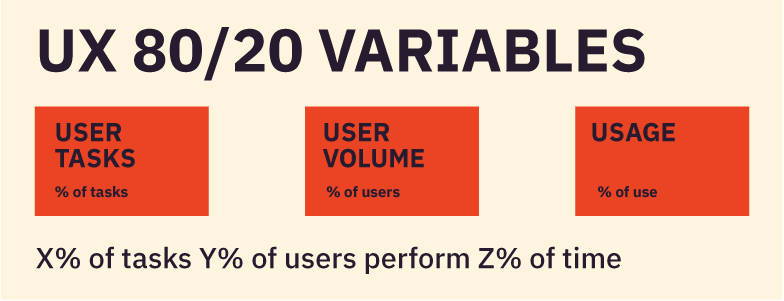By the year 2020, customer experience will overtake price and product as the key brand differentiator.
Some may say that we are already in the age of customer experience. That implies a laser like focus and due diligence on user experience (UX) elements that matter the most.
One way to bring in focus is by using the 80/20 rule. The 80/20 rule, also known as the Pareto Principle, states that 80% of results in a system come from 20% of the causes. Its origins stem back to Vilfredo Pareto, an economist who noticed 80% of Italy’s land was owned by 20% of the population. Though it might seem vague, the 80/20 way of thinking can provide insightful and endlessly applicable analysis of lopsided systems, including user experience strategy.
You have most likely heard some variation of the following examples:
- 80% of work productivity comes from 20% of the time you put in
- 80% of errors are caused by 20% of code
- 80% of revenue comes from 20% of customers
- 80% of sales come from 20% of sales staff
- 80% of attention is spent on 20% of the web page
Don’t get hung up in the numbers 80/20, as it will vary slightly from context to context. However the crux of the principal lies in knowing that, within any system, only a few main variables affect the outcomes, and most other factors will return little or no impact, so represent poor investment in time and effort.
It’s a matter of narrowing your focus down to essential cause and effect principles, so as to prioritize your attention and resources.
So how can you best implement knowledge of the 80/20 rule to user experience initiatives?
Figure out where an imbalance of effects exists. Where are you pouring most of your money? What do you spend most of your time working on? What aspect of your product holds the most value?
Try to figure out the 10–40% of inputs directly influencing most of your results, and, depending on the nature of the system, work to either amplify or downplay these inputs. If 80% of customer complaints are coming from one defect of your product, obviously effort needs to be focused there. If you notice 80% of traffic is being spent on particular area of your site, focus on tailoring that portion of the site to fit your users needs more directly.
In the enterprise context where features and use cases always hog the limelight, leveraging the Pareto principle or its derivatives can bring in a focus towards simplicity and superior experience. However there are multiple variables at play that should be used as guiding principles, in applying a Pareto like rule for effective UX strategy:

Example: focus attention on the elements related to the top 15% of tasks used by 90% of users, 80% of the time. The target numbers for each variable will depend on many factors including product maturity, industry, type of users, context of usage, business goals, etc.
The unavoidable truth is that you have finite resources to figure out an infinite amount of problems. Figure out what matters most, then invest your time and effort into the key areas that will help deliver the greatest impact.
Arin Bhowmick (@arinbhowmick) is Vice President, Design at IBM based in San Francisco, California. The above article is personal and does not necessarily represent IBM’s positions, strategies or opinions.
This post originally appeared on Medium in July 2017 and is being reposted with permission from the author

